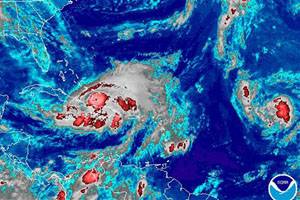Hanna lashes Bahamas, threatens US East Coast

This false-color satellite image provided by the National Oceanic and Atmospheric Administration shows Hurricane Hanna in the Bahamas at 4:45 a.m. EDT. Forecasters said it could threaten the southeast United States by midweek. (AP Photo/NOAA)
September 1, 2008
PROVIDENCIALES, Turks and Caicos — Hurricane Hanna slumped to tropical storm strength on Tuesday even as it caused killer floods, and forecasters said it still poses a hurricane threat to the U.S. East Coast.
The storm spawned flooding in Haiti that killed at least 10 people, raising the storm’s regional death toll to 11.
The 10 bodies were found Tuesday in Gonaives along Haiti’s western coast, said Marie Alta Jean-Baptiste, the country’s civil protection director.
“The situation is as bad as it can be,” said Vadre Louis, a U.N. investigator based in Gonaives. “The wind is ripping up trees. Houses are flooded with water. Cars can’t drive on the street. You can’t rescue anyone wherever they may be.”
Hanna’s maximum sustained winds slipped to 70 mph (110 kph), but the U.S. National Hurricane Center in Miami said it still has the potential to become a hurricane again by Thursday.
The hurricane center said its forecast track would carry Hanna toward “the east coast of Florida, Georgia or South Carolina in two to three days.”
But it said the track was uncertain and that the entire Southeastern U.S. coast should closely monitor the storm.
Hanna’s movement has been agonizingly slow for people in the tourist magnets of the Bahamas and the Turks and Caicos, directly under its winds.
Trees snapped and power was out in Providenciales, capital of the Turks and Caicos islands.
The storm was just southeast of Great Inagua island in the Bahamas Tuesday afternoon and was drifting southeastward. Forecasters said they expected it eventually to head toward the northwest and reach the central Bahamas by Wednesday.
As the storm began its slow march over Great Inagua, there was “a bit of heavy wind,” that toppled some power lines but caused no major damage or injuries, Royal Bahamas Police Force Inspector Dencle Barr said from the island. Great Inagua still faced another 12 hours or so of Hanna’s passage.
Newly formed Tropical Storm Ike was cruising westward across the central Atlantic and was projected to near the storm-weary Bahamas by Sunday. It had winds of 60 mph (95 kph) and could become a hurricane on Wednesday.
Still further to the east, Tropical Storm Josephine formed Tuesday and it was heading west at about 15 mph (24 kph), with maximum sustained winds of about 40 mph (65 kph). The hurricane center said it could near hurricane force by Wednesday or Thursday.
And in the Pacific, Tropical Storm Karina formed south of the Baja California Peninsula with sustained winds of 40 mph (65 kph). The hurricane center said it was expected to head out to sea without hitting land. A man from Colombia died and a Brazilian woman was missing on Monday after they were swept away in a river swollen by Hanna’s rains. The two were students at the University of Puerto Rico on a trip to the island’s east.
More than 8,000 Haitians remain homeless in the wake of Hurricane Gustav, which was downgraded to a tropical storm as it moved over central Louisiana late Monday.
More than 100 people have been killed by storms in Haiti in the last month alone.
Hanna prompted NASA to put off shifting the space shuttle Atlantis from an assembly building at Florida’s Kennedy Space Center to the launch pad for at least a day. The move had been scheduled for Tuesday in preparation for an October mission to the Hubble Space Telescope.






